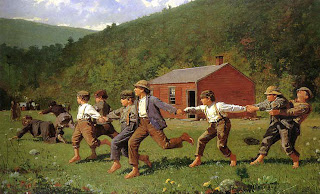Emanuel Leutze
LEUTZE, Emanuel, historical painter, born in Gmund, Wurtemberg, 24 May, 1816; died in Washington, D. C.. 18 July, 1868. His parents emigrated to the United States soon after his birth, and at first settled in Philadelphia, but subsequently removed to Fredericksburg, Virginia His early education was good, though not especially in the direction of art. The first development of his artistic talent occurred while he was attending the sick bed of his father, when he attempted drawing to occupy the long hours of waiting. He soon became skilful, and projected a plan for publishing, in Washington, portraits of eminent American statesmen, in which, however, he met with but slight encouragement. About 1840 he produced a painting whose merits were such as to procure him many orders, so that in 1841 he was enabled to study in Dusseldorf under Lessing. He devoted himself to historical subjects, choosing in preference those having a relation to the discovery or history of America. His first noteworthy painting in Europe, "Columbus before the Council of Salamanca," was purchased by the Dusseldorf art union; and a companion picture, "Columbus in Chains," procured him the gold medal of the Brussels art exhibition, and was subsequently purchased by the Art union in New York. In 1843 he studied the works of Cornelius and Kaulbach at Munich, and, while there, finished his "Columbus before the Queen." On the completion of this picture he visited Venice and Rome, making studies from Titian and Michael Angelo, and, after a tour in Italy, returned to Diisseldorf in 1845, where he married and made his home. For fourteen years he continued in that city, during which period he painted "Landing of the Norsemen in America," "Cromwell and his Daughter," "The Court of Queen Elizabeth," "Henry VIII. and Anne Boleyn," "The Iconoclast," "John Knox and Mary Stuart," and the series of pictures illustrating striking events in the war of the Revolution, of which the more important were "Washington Crossing the Delaware," "Washington at Mortmouth," "Washington at the Battle of Monongahela," "News from Lexington," "Sergeant Jasper," and "Washington at Princeton." In 1859 Mr. Leutze returned to the United States and opened a studio in New York city. Early in 1860 he received a commission from the government for a large mural picture, to be painted on one of the staircases in the Capitol at Washington. The subject chosen was "Westward the Star of Empire takes its Way," and the painting was to be executed in fresco. So earnestly did the artist enter into this work that he not only made the then difficult journey to the base of the Rocky mountains, for the purpose of local study, but, on his return, again departed for Munich, that he might learn from Kaulbach the mechanism of fresco painting. He was elected a member of the National academy in 1860, and in 1867 exhibited his "Elaine" there. After his death there were shown at the academy his "Mother's Visit, .... Storming of Teocalli, Mexico," and "Settlement of Maryland by Lord Baltimore," together with portraits of General Grant, General Burnside, and several artists. His "Mary Stuart hearing the First Mass at Holyrood after her Return from France" was at the Paris exhibition of 1867. Besides his "Westward Ho!" as it is sometimes called, he had received other commissions from the government, which were only in the "cartoon" state at his death. One of these, "Civilization," was intended for the senate-chamber. He had also made a sketch in pencil of an historical painting of the largest size. entitled 's "The Emancipation." One of the artist most successful works is "Lafayette in Prison at Olmutz Visited by his Relatives" (1861).--His eldest son, Eugene H. C., entered the United States navy 4 March, 1863, and was commissioned lieutenant in 1871, which rank he still (1887) holds.
Edited Appletons Encyclopedia, Copyright © 2001 VirtualologyTM
Soure:
http://www.famousamericans.net/emanuelleutze/











